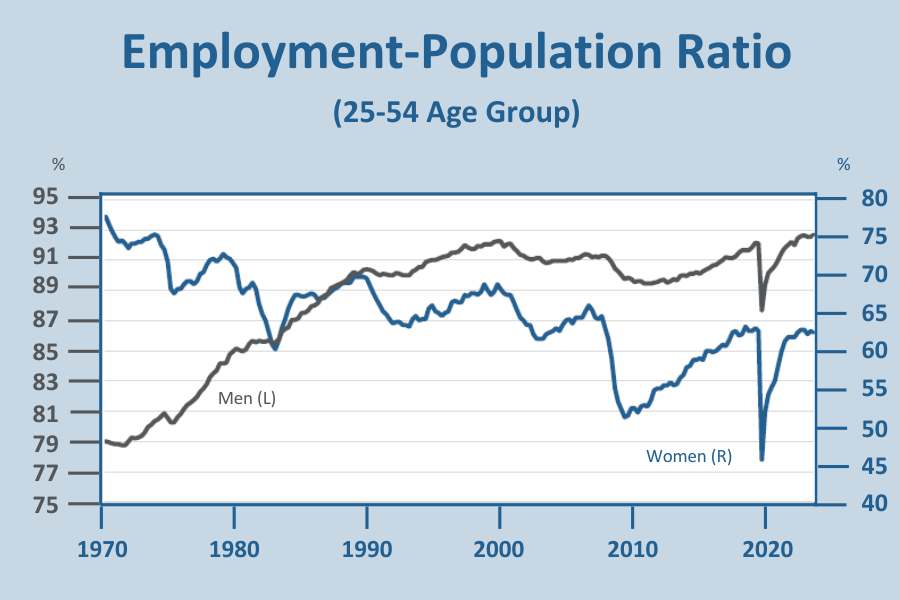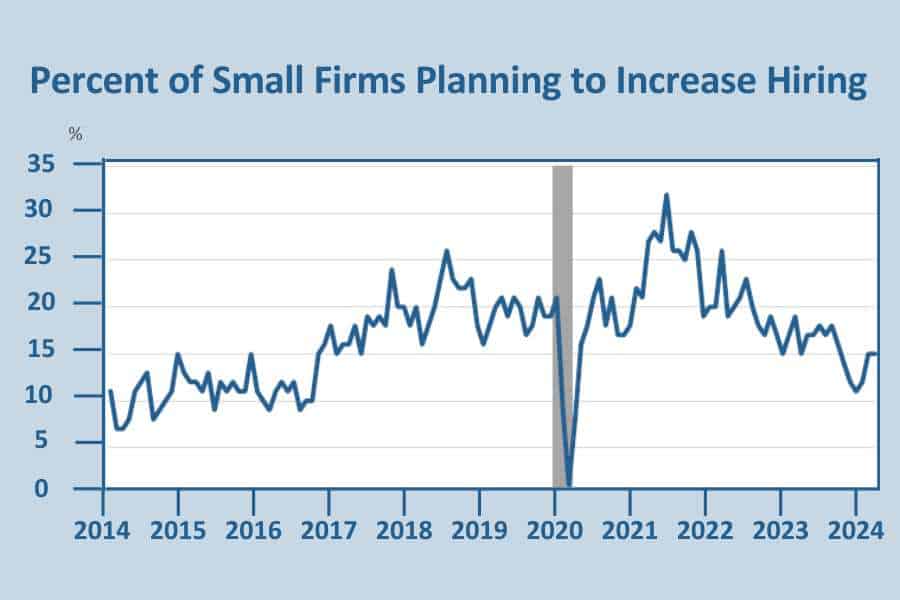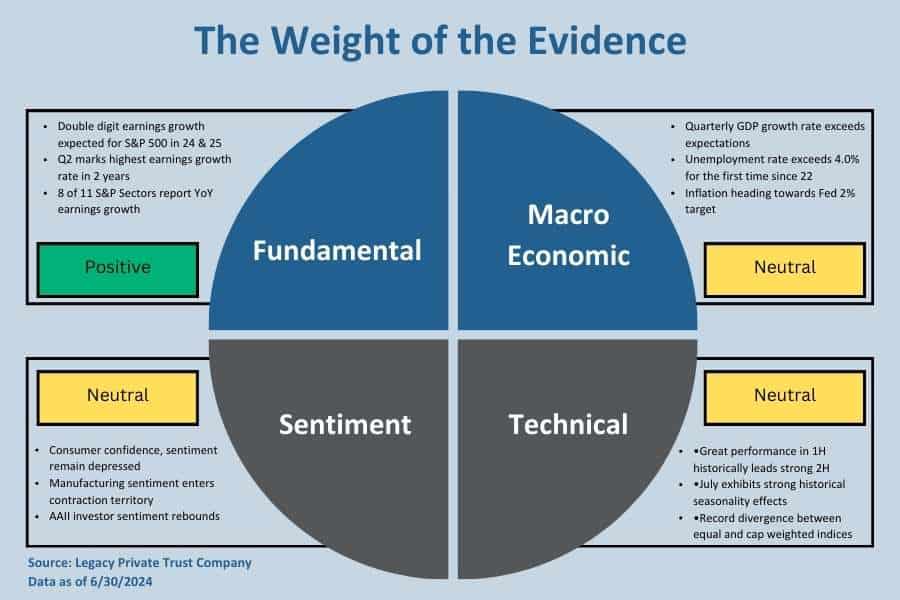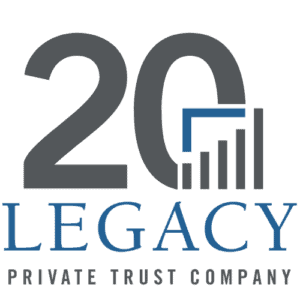In the spring of 2022, the Federal Reserve embarked on a mission to wrestle inflation under control without sinking the economy. At the time, the Fed’s preferred inflation measure, the core Personal Consumption Deflator, increased at 5.5% year-over-year, and the unemployment rate stood at 3.6%. Over the following 12 months, the Fed stepped on the brakes harder and harder, lifting their short-term policy rate from near zero to a range of 5.25%-5.50% in July of 2023. At that point, inflation had retreated to 4.3%, which was good but not close enough to the central bank’s 2% target. With unemployment still at a historically low 3.5%, policymakers stayed the course, keeping rates unchanged at peak levels until they saw more progress on the inflation front.
Fast forward to now, and inflation as measured by the Fed’s preferred inflation gauge (personal consumption expenditures excluding food and energy) has receded to 2.6% year-over-year, putting the 2% target within sight. Stripping out the lagged shelter component (Owner-equivalent Rent) brings inflation below the Fed’s 2% target on a 3, 6, and 12-month basis. Meanwhile, the unemployment rate has crept up to 4.1%. That’s still low by historical standards, but the half-percent increase from its low point is rarely seen outside of a recession. The economy is still chugging along, but history shows that once the unemployment rate strings together several consecutive monthly increases, stopping before a recession sets in is difficult. So, should the Fed declare “mission accomplished” and start unwinding its rate hikes before it’s too late? Remember that monetary policy affects the economy with a lag, and waiting too long could put the Fed behind the curve.
That is the debate currently running through the financial markets and keeping Fed officials up at night. The Fed professes to be data-driven; if they align policy with the latest batch of reports, they should start cutting rates now. However, the numbers do not always tell the whole story, and how many months of data are needed to confirm a trend is unclear. When inflation more than doubled during the first year following the pandemic lockdown, the flareup was so rapid and occurred amid such unusual circumstances that the Fed thought it would be “transitory” and stayed on the sidelines. That was a blunder, of course, as inflation continued to rise for another year until the Fed finally stepped in. That unfortunate episode is undoubtedly keeping the Fed far more cautious now than they otherwise would be, fearing a premature easing before inflation is defeated. As it turns out, however, the forces driving up inflation in 2021-22 were indeed transitory; it just took longer for them to unwind than expected. They mostly have, and the Fed is risking another blunder – waiting too long to ease up on the brakes.
Thank You Ladies
Many catalysts lit the fire under inflation during the early years of the post-pandemic recovery. The trillions of dollars of demand-fueled stimulus payments that collided with severely constrained supply chains were topping the list. The ensuing supply shortfall was pronounced in both the product and labor markets. When lockdowns were lifted, the supply chains in the goods markets were the first to heal, as production came back on stream, ports unclogged, global trade resumed, and the shortage of parts eased, allowing factories to refill order backlogs.
However, the labor market was slower in recovering and meeting the intense worker demand. Health concerns kept employees away from contact work. Older workers whose home prices and 401(k) balances ballooned took early retirements. Toughened immigration policy stifled the inflow of foreign job seekers. Importantly, family responsibilities kept parents home, particularly women who left the labor force in droves. The resulting labor shortage drove up wages and stoked the Fed’s biggest fear of a wage-price spiral that continued until recently.
However, the labor market eventually jumped on the recovery trail as people returned to the labor force. The pandemic’s grip on the nation eased, higher wages lured workers off the sidelines, people with lower incomes spent their stimulus checks and needed paychecks, and the intense competition for labor opened up job opportunities to a broader swath of marginal workers. An aging population continued to spur retirements, preventing the overall labor force participation from reaching pre-pandemic levels. However, the workforce’s prime-age (25-54) segment fully recovered by early last year and climbed to a new high this year. Notably, women led the charge. Indeed, more working-age women are working than ever before in U.S. history, leaving their male counterparts in the dust. The rise in flexible work arrangements, including working remotely from home, clearly contributed to the increase, particularly for college-educated women with young children.

Rebalancing Almost Complete
Unsurprisingly, wage growth slowed as the supply of labor expanded, and the number of vacant jobs competing for workers declined. At the time of the first rate hike in March 2022, there were two job openings for every unemployed worker, and the year-over-year increase in average hourly earnings soared to just under 6%. By May of this year, vacancies had dropped to 1.2 per worker, almost spot-on with the average for 2019, and earnings growth subsided to 3.9%.
The rebalancing of the labor market explains why the Fed feels more confident that inflation is on a sustainable path toward 2%. There is still a way to go, as wage growth would need to slow to around 3.5%, which, assuming 1.5% productivity growth, would be consistent with a 2% inflation rate.
The good news is that the rebalancing in the labor market is unfolding just the way the Fed wants. Supply is increasing, and hiring is slowing. However, companies are not purging workers from payrolls to control labor costs. Simply put, workers are reentering the labor force, but not all of them are finding jobs right away, which is why the unemployment rate is creeping up – and wage growth is slowing. That may not be ideal for job seekers, but if the unemployment rate rose because companies were engaged in massive layoffs, the broader economy would suffer far more damage than is currently the case.
Warning Signs
That said, it would be a mistake to be overly complacent about the labor market’s resilience. As noted earlier, it is difficult to stop when conditions start to weaken. So far, the half-point climb in the unemployment rate is not particularly worrisome because it was historically low when the climb began and remains well below recessionary levels. Likewise, the number of workers filing for unemployment benefits is also well below that recessionary threshold. However, the trend in both bears watching is that it could quickly gain traction before policymakers can get a handle on it.
As it is, other signs of deteriorating labor conditions are becoming more visible. While layoffs are still subdued, it is taking longer for workers on the unemployment lines to find a job. The percentage of workers out of a job for more than 27 weeks has risen for five consecutive months and, at 22.2%, is the highest since early 2022. The job finding rate, the percent of unemployed workers last month who are employed this month, has also been trending lower, and small business hiring plans, which account for the bulk of new jobs, recently hit a four-year low.
So far, the cracks in the labor market have not significantly affected economic activity. Although the economy’s first-half performance was underwhelming, to say the least, its key growth driver, consumer spending, has held up, thanks mainly to the muscle provided by upper-income households who have benefited immensely from a strong stock market and surging wealth from home equity. There is no reason to think they will suddenly zip up their wallets, but those in the less wealthy cohort are tightening their belts, and many are falling on hard times as credit card and auto loan delinquencies are rising.
Risk of Waiting
Lower-income households can overcome their financial struggles if a resilient job market continues to provide them with paychecks. However, they are the first to be left behind once hiring slows. Worse, when companies decide to downsize, they are usually the first to go. While this distressing cycle has yet to materialize, heightened job insecurity permeates the workforce. Fewer workers voluntarily quit, and the wage premium for switching jobs has narrowed.
Should this feeling of job insecurity escalate, it is only a matter of time before households pull back spending and decide to build up precautionary savings. At that point, the path to a recession would become wider. With the job market still cranking out around 200,000 payrolls a month, it does not seem that worries over employment opportunities are justified. However, recent job gains are coming from a narrowing group of sectors, with government and healthcare providing most of the increase. Signs of frugality are already appearing on several fronts, as the personal savings rate is creeping up and price-conscious consumers are trading down, something that is starkly revealed in recent earnings calls of high-profile retailers.

The Fed needs to stave off the prospect of an abrupt consumer pullback by relieving the financial burden on lower-income households, cutting borrowing costs sooner rather than later. True, there is the risk that the inflation retreat could stall out. Indeed, further year-over-year progress will be harder to come by as incoming data will be compared to the low readings in the second half of last year when inflation was falling sharply. What’s more, shipping costs have recently spiked, which some commentators attribute to importers pulling forward deliveries to avoid possible higher tariffs next year, which has become an election issue. However, a renewed inflation flareup is unlikely to stick unless other conditions are in place, most notably a tight labor market driving up wages, which is no longer the case. And, if a repeat of the first quarter’s inflation flareup does occur, the Fed can always stop cutting rates temporarily to avoid undercutting its inflation-fighting mission.

If you are a Legacy client and have questions, please do not hesitate to contact your Legacy advisor. If you are not a Legacy client and are interested in learning more about our approach to personalized wealth management, please contact us at 920.967.5020 or connect@lptrust.com.
The information contained herein is for informational purposes only and does not constitute a recommendation or advice. Any opinions are those of Legacy Private Trust Company only and represent our current analysis and judgment and are subject to change. Actual results, performance, or events may differ based on changing circumstances. No statements contained herein constitute any type of guarantee, nor are they a substitute for professional legal, tax, or other specialized advice.




